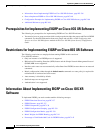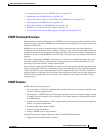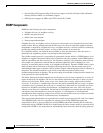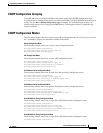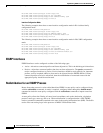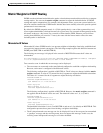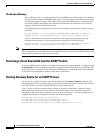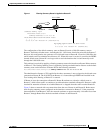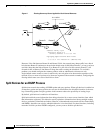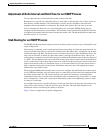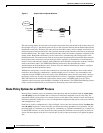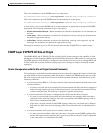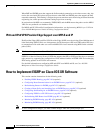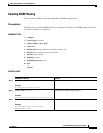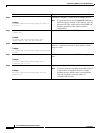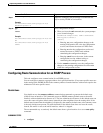
Implementing EIGRP on Cisco IOS XR Software
Information About Implementing EIGRP on Cisco IOS XR Software
RC-144
Cisco IOS XR Routing Configuration Guide
OL-14356-01
Figure 2 Floating Summary Route Applied for Dual-Homed Remotes
However, if the link between Router-D and Router-E fails, the network may dump traffic into a black
hole because Router-E continues to advertise the default route (0.0.0.0/0) to Router-C, as long as at least
one link (other than the link to Router-C) to Router-E is still active. In this scenario, Router-C still
forwards traffic to Router-E, but Router-E drops the traffic creating the black hole. To avoid this
problem, you should configure the summary address with an administrative distance on only
single-homed remote routers or areas in which only one exit point exists between the segments of the
network. If two or more exit points exist (from one segment of the network to another), configuring the
floating default route can cause a black hole to form.
Split Horizon for an EIGRP Process
Split horizon controls the sending of EIGRP update and query packets. When split horizon is enabled on
an interface, update and query packets are not sent for destinations for which this interface is the next
hop. Controlling update and query packets in this manner reduces the possibility of routing loops.
By default, split horizon is enabled on all interfaces.
Split horizon blocks route information from being advertised by a router on any interface from which
that information originated. This behavior usually optimizes communications among multiple routing
devices, particularly when links are broken. However, with nonbroadcast networks (such as Frame Relay
and SMDS), situations can arise for which this behavior is less than ideal. For these situations, including
networks in which you have EIGRP configured, you may want to disable split horizon.
158001
RP/0/RP0/CPU0:router# show route
address-family ipv4
interface POS03/0/0
summary-address 0.0.0.0/0 250
. . . .
0.0.0.0/0 via <Router-A> (489765/170)
Router-D Router-E
Router-C
Router-A Router-B
0.0.0.0/0
0.0.0.0/0
0.0.0.0/0
0.0.0.0/0
10.1.1.0/24



